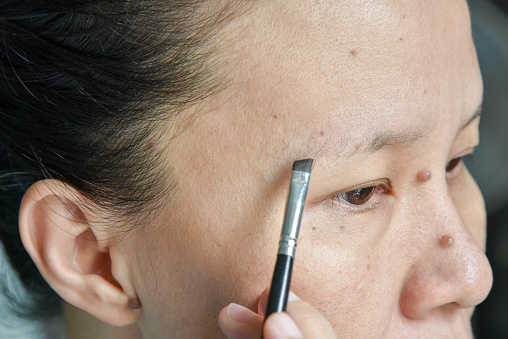A common question of people who have lost a significant amount of eyebrow hair is whether or not new hair will grow back. There are many causes for eyebrow hair loss, and this article will discuss some of the most commonly experienced types.

It’s important to note that eyebrows typically do grow back, though this may take some time depending on the cause and severity of the damage. Additionally, it’s important to remember that your lifestyle can play a key role in your body’s ability to recover from certain conditions [for example smoking].
The following is a list of potential reasons why you might not be able to grow more eyebrow hairs. It should be noted that while these issues may affect a person’s eyebrows, they may also affect other parts of their body, such as foot hair [example: athlete’s foot].
Alopecia Areata
This is a condition in which the immune system mistakenly attacks and destroys healthy body tissue. In this case, the tissue destroyed is your hair follicles, and it can affect both your scalp and eyebrow hairs. The exact cause of alopecia areata is unknown, but there may be a genetic component to it.
Regardless of its root causes, alopecia areata has no cure; however, the condition typically goes into remission on its own after several years. During this time new hair often grows back without treatment. Unfortunately for some people, the condition reoccurs at a later date.
Anxiety
Feeling stressed out about something, such as your hair falling out, may cause you to pull the hair in an attempt to relieve that stress. This creates a compulsive habit of plucking and pulling at eyebrow hairs. If this is done frequently enough, eyebrows can become permanently damaged and stop growing back.
Chemotherapy
As with alopecia areata, chemotherapy can also affect your hair follicles and lead to permanent damage and loss of eyebrow hair [source: American Cancer Society]. However, new brows typically begin growing once chemotherapy treatment is over. It should be noted that chemo drugs do not directly target your hair follicles, but they can damage them enough to prevent regrowth.
Genetics
If your parents or grandparents have had issues with eyebrow baldness, then you likely inherited a genetic predisposition for it. It should be noted that the age at which familial alopecia begins may differ between relatives due to wide variations in genes and other factors.
Male Pattern Baldness
This type of hair loss is also known as androgenic alopecia and affects up to 50% of men by their 60th birthday. In male-pattern baldness, the hairs on the top of the head begin thinning out. The reason why this happens is currently unknown, but it’s believed to be related to the male hormone testosterone.
Sunburn
If your eyebrows are exposed to too much sun and wind, then the follicles may become damaged and lead to permanent hair loss. If you notice that your brows aren’t growing back after a day at the beach or on a skiing trip, this could be what’s causing it.
Thyroid Disease
Having an underactive thyroid can cause some serious medical issues, one of which is eyebrow hair loss. Fortunately, there are treatments available for those who have been diagnosed with hypothyroidism. As with alopecia areata, new eyebrows can grow back once the condition is under control.
Traction Alopecia
If you wear tight hairstyles such as braids, cornrows or ponytails for an extended period, then your eyebrows and eyelashes may stop growing back. Additionally, wigs and weaves can also cause damage to eyebrow hairs.
Once again this is a type of hair loss that’s most often seen in African-American women; however, it can occur in people with lighter hair as well. Fortunately, there are treatments available for those who have been diagnosed with traction alopecia. New hairs will typically begin to grow back as soon as they’re allowed to grow freely.
Trichotillomania
This is a psychological condition in which sufferers believe that pulling out their eyebrow hairs will cause them to grow back thicker or more symmetrical, even though this is not the case. The trichotillomania compulsion can become so strong that you’ll pull out your eyebrows without realizing it, which is what leads to alopecia areata. Fortunately, there are treatments available for those who suffer from this condition. New hairs typically begin growing back as soon as the compulsion stops.
Trauma
If you accidentally pluck too many eyebrow hairs or use harsh chemicals, then the follicles may stop producing new ones.
Vitamin Deficiency
A lack of vitamins can affect your hair in several ways, including loss. Since brow hairs are generally produced at the temples, it’s not uncommon for people to notice significant hair loss in this area when they’re deficient in vitamin B6 or biotin.
Extreme Stress
If you’ve recently experienced a traumatic event or have had an extremely stressful period, then some eyebrow hair loss may occur [source: Mayo Clinic]. However since stress is more often linked with telogen effluvium rather than alopecia areata, any eyebrows that do grow back will likely be lighter and thinner than usual.
For more information on why aren’t my eyebrows growing, just click it.
